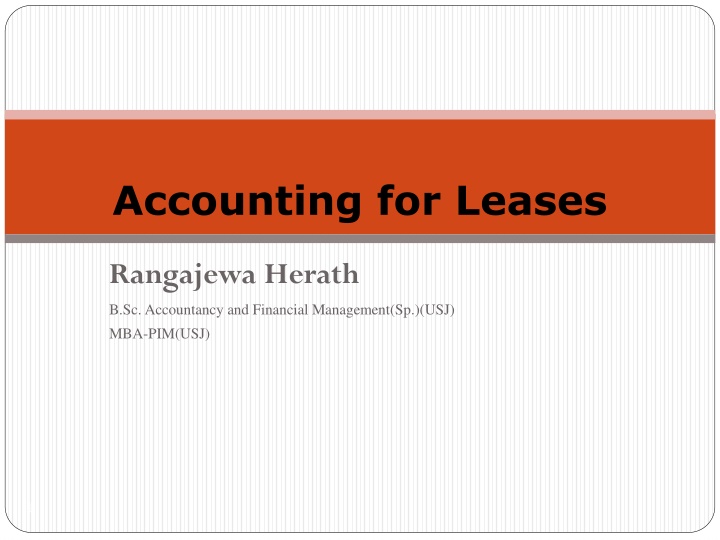
Accounting for Leases
Explore the fundamentals of accounting for leases, including the classification of finance and operating leases, examples of lease situations, and accounting treatment in the books of lessees. Enhance your knowledge and grasp essential concepts in lease accounting.
Download Presentation

Please find below an Image/Link to download the presentation.
The content on the website is provided AS IS for your information and personal use only. It may not be sold, licensed, or shared on other websites without obtaining consent from the author. If you encounter any issues during the download, it is possible that the publisher has removed the file from their server.
You are allowed to download the files provided on this website for personal or commercial use, subject to the condition that they are used lawfully. All files are the property of their respective owners.
The content on the website is provided AS IS for your information and personal use only. It may not be sold, licensed, or shared on other websites without obtaining consent from the author.
E N D
Presentation Transcript
Accounting for Leases Rangajewa Herath B.Sc. Accountancy and Financial Management(Sp.)(USJ) MBA-PIM(USJ) 1
Learning Outcomes At the end of this chapter, you should be able to: Explain what a lease represents Distinguish between an operating and a finance lease Account leases in the books of lessor and lessee Account sale and lease back transactions 2
Lesson Outline Accounting for Finance Leases Lessee's Books Accounting for Operating Leases Lessee's Books Accounting for Sale and Leaseback 3
A Lease A lease is an agreement whereby lessor conveys to the lessee in return for a payment or series of payments, right to use an asset for an agreed period of time. 4
Classification of Leases Finance Lease Operating Lease A lease that does not transfer substantially all risks and rewards incidental to the ownership of the asset. A lease that transfers substantially all risks and rewards incidental to the ownership of the asset. 5
Examples of Situations of finance leases The lease transfers ownership to the lessee by the end of the lease term. The lessee has the option to purchase the asset at a price that is expected to be sufficiently lower than the fair value. The lease term is for the major part of the economic life of the asset even if title is not transferred. At the inception of the lease PV of the MLP amounts to at least substantially all of the fair value of the asset. The asset is of such a specialized nature that only the lessee can use it without major modification. 6
Accounting for Finance Lease In the Books of Lessee 7
Initial Recognition of Finance Lease Assets and liabilities in the Statement of Financial Position should be recognized lower of fair value of the leased property or PV of minimum lease payments (PV of MLP) 8
What is PV of MLP? What is MLP? What discount rate is to be used when calculating PV of MLP? 9
Subsequent Measurement Minimum Lease Payments: apportion between the finance charge and the reduction of the outstanding liability. Finance Charge: allocate to the each period during the lease term so as to produce a constant periodic rate of return on remaining balance of the liability. Actuarial method Sum of years digits Straight line method 10
Depreciation Depreciation policy should be consistent with freehold assets and the depreciation recognized should accordance with LKAS 16. be allocated in If there is a reasonable certainty that the ownership will pass to the lessee at the end of the lease term, the period of expected use is the useful life of the asset. If not, depreciated at the shorter of the lease term and its useful life. 11
Accounting for Operating Lease In the Books of Lessee Shall be recognized as an expense on a straight line basis over the lease term unless another systematic representative of the time pattern of the user s benefit. basis is more 12
Accounting for Sale and Leaseback Finance Lease Operating Lease Secured Loan Straight forward Sale Sales Price = Fair Value Recognise Profit/Loss immediately. Profit is not immediately recognized as income in the F/S of the seller-lessee. Deferred and amortized over the lease term. Sales Price < Fair Value Recognise Profit/Loss immediately except the loss is compensated by future rentals at below market price. Then profit/loss deferr and amortise in proportion to the lease payments Sales Price > Fair Value The excess over fair value should be deferred and amortised 13
If Fair Value < Carrying Value of the Asset, at the time of sale and leaseback transaction Operating Lease: A loss equal to the amount of difference carrying value and fair value should be recognized immediately. between the Finance leases : Such adjustment not necessary unless there had been an impairment in value under LKAS 36. 14
Summary Leases are twofold; Finance and Operating Dealt with the accounting treatment for finance and operating leases in both books of the Lessee. Also, accounting treatment for Sale and Lease back transactions were discussed.
